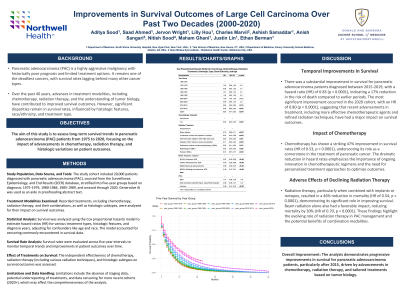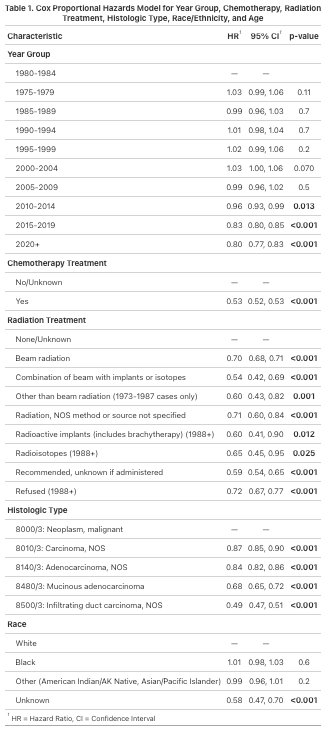Sunday Poster Session
Category: Biliary/Pancreas
P0028 - Improvements in Treatment of Pancreatic Cancers Over the Last Forty Years
Sunday, October 27, 2024
3:30 PM - 7:00 PM ET
Location: Exhibit Hall E

- AS
Aditya Sood, MD
Northwell Health-NSLIJ
Manhasset, NY
Presenting Author(s)
Saad Ahmed, MD1, Aditya Sood, MD2, Jervon Wright, MD1, Lilly Hou, MD1, Charles Marvil, MD3, Ashish Samaddar, MD1, Justin Lin, MD1, Ethan Berman, MD1, Anish Sangari, MD4, Nitish Sood, MD5
1North Shore University Hospital/Zucker School of Medicine at Hofstra University, New York, NY; 2Northwell Health-NSLIJ, Manhasset, NY; 3Yale Digestive Diseases, New Haven, CT; 4Emory University School of Medicine, Atlanta, GA; 5University of Oklahoma College of Medicine, Oklahoma City, OK
Introduction: Pancreatic adenocarcinoma (PAC) is a highly aggressive cancer with a traditionally poor prognosis and limited treatment options. This study analyzed long-term survival trends for PAC patients diagnosed from 1975 to 2020, focusing on the impact of treatment modalities.
Methods: Utilizing data from the Surveillance, Epidemiology, and End Results (SEER) database, we examined a cohort of 20,000 PAC patients, incorporating variables like diagnosis year, treatment types, histologic features, race/ethnicity, and age. Survival influences were assessed using a Cox proportional hazards model. Abstract text was proofread with aide of large language models; listed authors primarily wrote and oversaw edits made by large language models.
Results: The analysis highlighted improved survival over time; for instance, patients diagnosed between 2015-2019 had a hazard ratio (HR) of 0.83 (95% CI: 0.80-0.85, p < 0.001), improving to 0.80 (95% CI: 0.77-0.83, p < 0.001) for those diagnosed in 2020 or later. Chemotherapy, particularly with new agents, reduced the hazard rate by 47% (HR of 0.53, 95% CI: 0.52-0.53, p < 0.001). Radiation therapy's effectiveness varied by type; beam radiation alone resulted in a HR of 0.70 (95% CI: 0.68-0.71, p < 0.001), and in combination with implants or isotopes, a HR of 0.54 (95% CI: 0.42-0.69, p < 0.001). Additionally, histologic type significantly influenced outcomes, with mucinous adenocarcinoma and infiltrating duct carcinoma showing HRs of 0.68 (95% CI: 0.65-0.72, p < 0.001) and 0.49 (95% CI: 0.47-0.51, p < 0.001), respectively. Race/ethnicity also played a critical role, affecting survival rates across different groups.
Discussion: This study confirms significant advancements in PAC treatment over the past four decades, especially in the most recent periods, demonstrating the effectiveness of new treatment approaches and improved management strategies. Chemotherapy and radiation therapy have substantially improved survival, underscoring the need for personalized treatment strategies. Further research is needed to address the limitations of absent staging data and data censoring in recent cohorts, to better understand long-term survival trends in PAC patients.

Disclosures:
Saad Ahmed, MD1, Aditya Sood, MD2, Jervon Wright, MD1, Lilly Hou, MD1, Charles Marvil, MD3, Ashish Samaddar, MD1, Justin Lin, MD1, Ethan Berman, MD1, Anish Sangari, MD4, Nitish Sood, MD5. P0028 - Improvements in Treatment of Pancreatic Cancers Over the Last Forty Years, ACG 2024 Annual Scientific Meeting Abstracts. Philadelphia, PA: American College of Gastroenterology.
1North Shore University Hospital/Zucker School of Medicine at Hofstra University, New York, NY; 2Northwell Health-NSLIJ, Manhasset, NY; 3Yale Digestive Diseases, New Haven, CT; 4Emory University School of Medicine, Atlanta, GA; 5University of Oklahoma College of Medicine, Oklahoma City, OK
Introduction: Pancreatic adenocarcinoma (PAC) is a highly aggressive cancer with a traditionally poor prognosis and limited treatment options. This study analyzed long-term survival trends for PAC patients diagnosed from 1975 to 2020, focusing on the impact of treatment modalities.
Methods: Utilizing data from the Surveillance, Epidemiology, and End Results (SEER) database, we examined a cohort of 20,000 PAC patients, incorporating variables like diagnosis year, treatment types, histologic features, race/ethnicity, and age. Survival influences were assessed using a Cox proportional hazards model. Abstract text was proofread with aide of large language models; listed authors primarily wrote and oversaw edits made by large language models.
Results: The analysis highlighted improved survival over time; for instance, patients diagnosed between 2015-2019 had a hazard ratio (HR) of 0.83 (95% CI: 0.80-0.85, p < 0.001), improving to 0.80 (95% CI: 0.77-0.83, p < 0.001) for those diagnosed in 2020 or later. Chemotherapy, particularly with new agents, reduced the hazard rate by 47% (HR of 0.53, 95% CI: 0.52-0.53, p < 0.001). Radiation therapy's effectiveness varied by type; beam radiation alone resulted in a HR of 0.70 (95% CI: 0.68-0.71, p < 0.001), and in combination with implants or isotopes, a HR of 0.54 (95% CI: 0.42-0.69, p < 0.001). Additionally, histologic type significantly influenced outcomes, with mucinous adenocarcinoma and infiltrating duct carcinoma showing HRs of 0.68 (95% CI: 0.65-0.72, p < 0.001) and 0.49 (95% CI: 0.47-0.51, p < 0.001), respectively. Race/ethnicity also played a critical role, affecting survival rates across different groups.
Discussion: This study confirms significant advancements in PAC treatment over the past four decades, especially in the most recent periods, demonstrating the effectiveness of new treatment approaches and improved management strategies. Chemotherapy and radiation therapy have substantially improved survival, underscoring the need for personalized treatment strategies. Further research is needed to address the limitations of absent staging data and data censoring in recent cohorts, to better understand long-term survival trends in PAC patients.

Figure: Cox Proportion Hazard Model
Disclosures:
Saad Ahmed indicated no relevant financial relationships.
Aditya Sood indicated no relevant financial relationships.
Jervon Wright indicated no relevant financial relationships.
Lilly Hou indicated no relevant financial relationships.
Charles Marvil indicated no relevant financial relationships.
Ashish Samaddar indicated no relevant financial relationships.
Justin Lin indicated no relevant financial relationships.
Ethan Berman indicated no relevant financial relationships.
Anish Sangari indicated no relevant financial relationships.
Nitish Sood indicated no relevant financial relationships.
Saad Ahmed, MD1, Aditya Sood, MD2, Jervon Wright, MD1, Lilly Hou, MD1, Charles Marvil, MD3, Ashish Samaddar, MD1, Justin Lin, MD1, Ethan Berman, MD1, Anish Sangari, MD4, Nitish Sood, MD5. P0028 - Improvements in Treatment of Pancreatic Cancers Over the Last Forty Years, ACG 2024 Annual Scientific Meeting Abstracts. Philadelphia, PA: American College of Gastroenterology.
